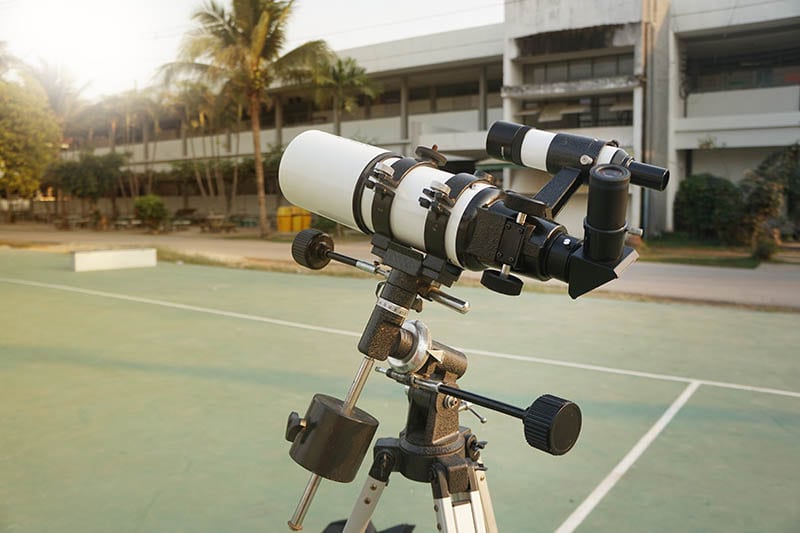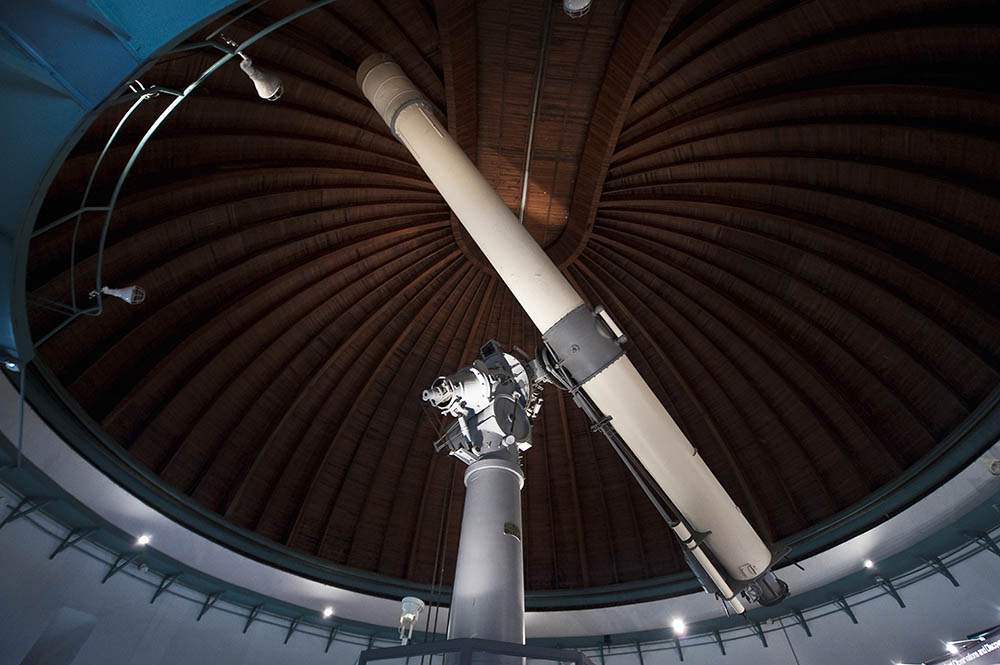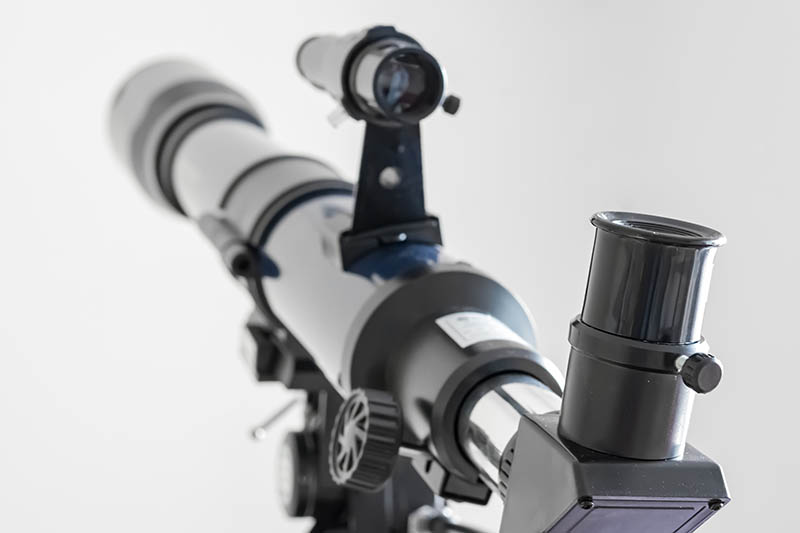What Are Refracting Telescopes? Pros, Cons, Types, & FAQ
Last Updated on

After the invention of the first telescope in 1608¹, there has been a constant effort to improve this technology. Many significant breakthroughs in understanding the universe have been made through advances in telescope design.
All these advancements revolve around the utilization of light in different ways. An example is a refracting telescope, which uses a biconvex lens to gather and focus light. It converges light rays on a focal point to form an image. On the other hand, the reflecting telescope uses a concave mirror to capture light and reflect it to a focal point.
Below is an overview of the refracting telescope and its benefits, so keep reading.

How Does It Work?
A refracting telescope is an optical telescope that uses a lens as its objective to gather and focus light. The lens is followed by a long tube, which houses the eyepiece. The eyepiece is a short focal length lens that magnifies the image formed by the objective lens. As a result, the user sees an enlarged image of the distant object.
- The primary objective lens is a concave lens that converges light rays to a single point in front of it.
- Then the eyepiece is a convex lens that increases the apparent size of the observed object.
- The distance between these two lenses determines the amount of magnification the telescope produces.
- The eyepiece is usually located near the front of the telescope, while the objective lens is at the back.
- When you observe an object through a refracting telescope, light from the object enters the telescope through the objective lens.
- The lens then bends (or refracts) the light and focuses it at a point in front of the lens, called the focal point. The eyepiece is present at the focal point. It magnifies the object’s image, making it easier for the viewer to see.
Magnification of Refracting Telescopes
The eyepiece of a refracting telescope magnifies the image formed by the objective lens. The amount of magnification provided by the eyepiece is calculated by dividing the objective lens’s focal length by the eyepiece’s focal length.
A telescope with an objective lens of 100 mm and an eyepiece of 10 mm would have a magnification of 100/10 or 10x.

An Overview of Refraction
To understand how the principle of refraction works in binoculars, telescopes, and long-focus lenses, it’s crucial to understand the physics of light. When a light wave encounters an object, it is either reflected, refracted, or scattered. Reflection occurs when the light wave bounces off the surface of the object. For example, this happens when you see your reflection in a mirror.
In refraction, the light wave bends as it passes through the object. For instance, if you put a stick or a pencil in a glass of water, it will look bent. The light waves bend around the object as they pass through the water.
Scattering occurs when the light wave hits the object and is scattered in all directions. You can see this by observing the sky on a cloudy day. The clouds scatter the light from the sun. That’s what makes the sky appear white.
Many applications, including telescopy, use refraction to bend light waves and bring them into focus. For example, the eyepiece of a telescope magnifies the image by using objective lenses to refract the light.
The speed of light depends on the refractive index of the medium it passes through. A higher refractive index means the light will travel slowly. For example, the refractive index of a vacuum is 1, while that of a diamond is 2.4. Thus, the light’s speed in a vacuum is about 1.3 times faster than in a diamond.
The light changes its speed when entering a new medium, but the direction remains the same. Telescopes leverage this by using a convex lens that converges the incoming light on a focal point. That’s how the eyepiece of a telescope makes distant objects appear closer. Magnifying the image allows you to see details that would otherwise be invisible to the naked eye. The same principle applies to binoculars, which combine two convex lenses to produce a magnified image.
What Are the Different Types of Refracting Telescopes?
Refracting telescopes differ by design. While some are designed for use in terrestrial observing, others are better suited for astronomical purposes. Here are four main types of refracting telescopes:
Galilean Telescope
The Galilean telescope, the first refracting telescope, was created by Galileo Galilei in 1609. It is the simplest type of refracting telescope. It has a plano-convex objective lens with a plano-concave eyepiece lens. Since there is a lack of intermediary focus, the telescope forms a non-inverted image.
If you use it with a few corrective devices, it can form an upright image. For example, the most powerful Galilean telescope could magnify objects by 30 times. However, the images formed with this telescope were blurry due to specific design flaws. For one, the lens shape wasn’t ideal for capturing clear images. Secondly, the telescope had a narrow field of view, which made it difficult for users to track objects.
- Moons of Jupiter
- Craters on the Moon
- Phases on Venus
Much of what we know about the solar system today was first discovered using the Galilean telescope.
Keplerian Telescope
https://www.instagram.com/p/CiZzbWdDWnp/
The Keplerian telescope is an advanced type of refracting telescope. It was created by Johannes Kepler, who was a contemporary of Galileo.
The Keplerian telescope has a convex eyepiece lens rather than the concave lens Galileo used. Since the light rays from the eyepiece converge, they provide a wider field of view. As a result, the image could be magnified more without losing focus.
It also had a longer focal length than the Galilean telescope, which meant it could be used to observe distant objects. Plus, the Keplerian telescope allowed the use of micrometers to observe the distance between objects. However, this telescope still formed an inverted image.
Achromatic Refractors
https://www.instagram.com/p/CQ0cWBED532/
A notable issue with the previous telescopes was the lack of correction for chromatic aberration. It is an error that occurs when different colors of light are bent at different angles by a lens. Chromatic aberration results in a blurred image.
In the mid-1700s, John Dollond and Chester Moore Hall developed an achromatic lens. It could support shorter focal lengths and correct chromatic aberration.
An achromatic lens does this by focusing two wavelengths in a single place. However, a problem with these lenses was that they had a glass construction.
In the mid-1700s, the glass-making techniques weren’t advanced enough to make an objective lens larger than four inches in diameter. Pierre-Louis Guinand, a Swiss optician, resolved this problem in the 19th century when he created an achromatic doublet.
The achromatic doublet has two types of glass with different refractive indices, which are glued together. It is still a component of modern achromatic refractors.
APO Refractors
Apochromatic refractors (APOs) are the highest quality refracting telescopes. They have been corrected for both chromatic and spherical aberration.
They work by focusing three wavelengths on the same plane instead of just two. It results in a highly sharp image that is free of distortion.
APOs use achromatic doublets as their objective lenses and extra lens elements to correct for spherical aberration. The eyepiece is usually an achromatic doublet or triplet.
Since these telescopes have more materials, they tend to be more expensive than the other types of refracting telescopes. Nevertheless, the Cooke triplet is undeniably one of the most iconic APO refractors.
- Spherical Aberration: An error occurs when light waves passing through a lens do not converge into a single focal point.
- Coma: In this type of aberration, off-axis light focuses into a comet-shaped blur instead of a point.
- Astigmatism: The light waves focus on a line instead of a point.
- Seidel Aberrations: The image is distorted by a type of aberration that occurs when the eyepiece lens does not perfectly align with the objective lens.
- Field Curvature: When you look through the edge of the eyepiece, the image appears curved.
Today, the Cooke triplet is still considered one of the best lenses for an APO refractor.

Where Is It Used?
The most notable application of refracting telescopes is in astronomical research. Large refractors were common in observatories worldwide before the invention of reflecting microscopes.
Today, smaller refractors are useful in various scientific fields such as terrestrial viewing. Refracting telescopes are also commonplace in many industries. These include factory machine vision systems, maritime navigation, and long-range shooting.
The most crucial use of the refracting telescope was in 1609. Galileo Galilei used a refracting microscope to discover the four largest moons of Jupiter. They are also called the Galilean satellites.
Some 19th-century astronomers used refracting telescopes for various purposes in spectroscopy and astrophotography. They used a refracting telescope with a heliometer to calculate the distance to the stars. The information helped develop the theory of stellar parallax.
With the development of photography in the late 19th century, refracting telescopes became popular for amateur astronomy. They allowed for long-exposure photographs of the night sky.

Advantages of Refracting Telescopes
Refracting telescopes have been used since the early days of astronomy. They offer many advantages over other types of telescopes.
Manageable Size
Refracting telescopes are generally much smaller and more portable than other telescopes. It makes them ideal for traveling and for taking to remote locations.
Higher Quality Images
The images a refracting telescope produces are sharper than those of other telescopes. In addition, since the lenses are not exposed to harsh environmental elements, they are less likely to become foggy or dirty, which can degrade the quality of the images.
Aberration Correction
Chromatic or Seidel aberrations can distort the images produced by a telescope. However, these aberrations are corrected more easily in refracting telescopes than in other telescopes.
Achromatic and apochromatic refractors are two types of refracting telescopes using different lens designs to correct chromatic aberrations. Astronomers can also use different lenses in combination to correct chromatic and spherical aberrations.
Low Dispersion
Modern apochromatic refractors contain objective lenses with low dispersion. As a result, it results in images free of chromatic aberrations.

Disadvantages of Refracting Telescopes
There are a few disadvantages to using refracting telescopes too.
Long Setup Time
It can be time-consuming to set up a refracting telescope correctly. First, you must align the lenses perfectly and ensure the telescope is level. If you don’t do this, you will notice a lot of distortion in the images.
Aberration
Unless you’re using a most recent and expensive telescope, you will probably still see some aberrations in the images. It can be complicated for astronomers to view the sky in a refracting telescope without additional materials. These include achromatic lenses that correct aberration.
Cost
Refracting telescopes are generally more expensive than other types of telescopes. The high-quality ones can cost thousands of dollars.


Frequently Asked Questions (FAQs)
What Is a Refracting Telescope Used For?
A refracting telescope observes distant objects by collecting and focusing light. Then, the telescope uses a lens to bend the light and form an image. Astronomers have used refracting telescopes to study the solar system, binary stars, and distant galaxies.
What Type of Image Does a Refracting Telescope Form?
A refracting telescope forms a virtual, inverted, and magnified image. A virtual image is an image that you cannot project onto a screen. Meanwhile, an inverted image is an upside-down image that has to be viewed in a mirror. The eyepiece of a refracting telescope magnifies the image by 30 or more times to make it easier to see.
How Is Light Collected in a Refracting Telescope?
An objective lens collects light and brings it to focus on a focal plane. The eyepiece is a small lens that magnifies the image so it can be seen more clearly.
How Do Refracting Microscopes Compare to Reflecting Microscopes?
Reflecting microscopes use mirrors to collect and focus light while refracting microscopes use lenses. Moreover, reflecting microscopes are generally more expensive than refracting microscopes but offer better image quality. Refracting microscopes are simpler, more compact, and lighter than their reflecting counterparts.
Can You See Planets With a Refracting Telescope?
An APO refractor can help you see planets. Since they have achromatic components, they are ideal for viewing planets without worrying about chromatic aberration.
Where Can We See a Refracting Telescope?
The Yerkes Observatory in Wisconsin is home to the world’s largest refracting telescope. The telescope has a lens that is 1.02 meters in diameter. Its tube was 18 meters long, making it huge for its time. The total weight of this telescope, including the attachments, is 20 tons.

Final Thoughts
The principle of a refracting telescope is that the light from a distant object is bent (refracted) as it passes through the lens. The refractive index of the lens material determines how much the light will bend.
The refractive index is a measure of how much the speed of light is reduced in the material. Refracting telescopes have applications in astronomy and terrestrial viewing.
Some types of astronomical refracting telescopes are the achromatic telescope and the apochromatic telescope. Modern telescopes have achromatic lenses to correct for the different bending of colors by the lens material.
Featured Image Credit: Yes058 Montree Nanta, Shutterstock
About the Author Jeff Weishaupt
Jeff is a tech professional by day, writer, and amateur photographer by night. He's had the privilege of leading software teams for startups to the Fortune 100 over the past two decades. He currently works in the data privacy space. Jeff's amateur photography interests started in 2008 when he got his first DSLR camera, the Canon Rebel. Since then, he's taken tens of thousands of photos. His favorite handheld camera these days is his Google Pixel 6 XL. He loves taking photos of nature and his kids. In 2016, he bought his first drone, the Mavic Pro. Taking photos from the air is an amazing perspective, and he loves to take his drone while traveling.
Related Articles:
Binocular Magnification Chart: Numbers & Distances Compared
How to Collimate Binoculars: 9 Expert Tips
What Is the Best Binocular Magnification for Hunting? Optical Features Explained
When Were Binoculars Invented? History, Today & Future
Can You Use Binoculars to Look At Stars? How to Choose the Right Pair
How to Choose Binoculars for Bird Watching: 10 Expert Tips
What Does 20X50 Mean on Binoculars? Our Helpful Guide
10 Best Binoculars in Canada of 2024: Reviews & Top Picks
